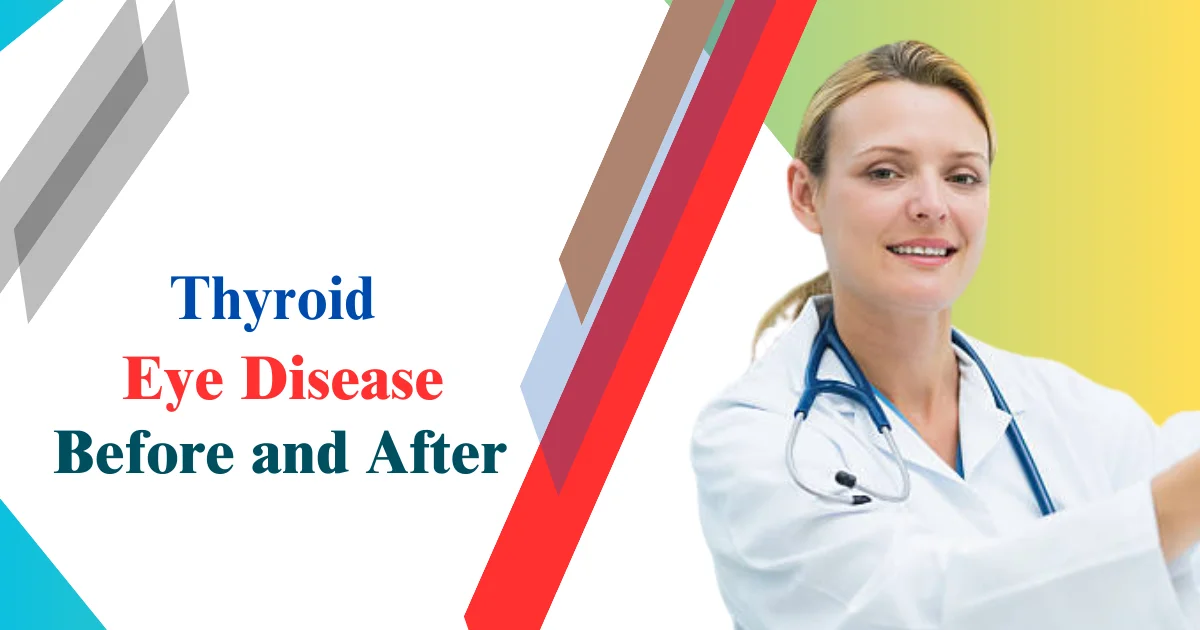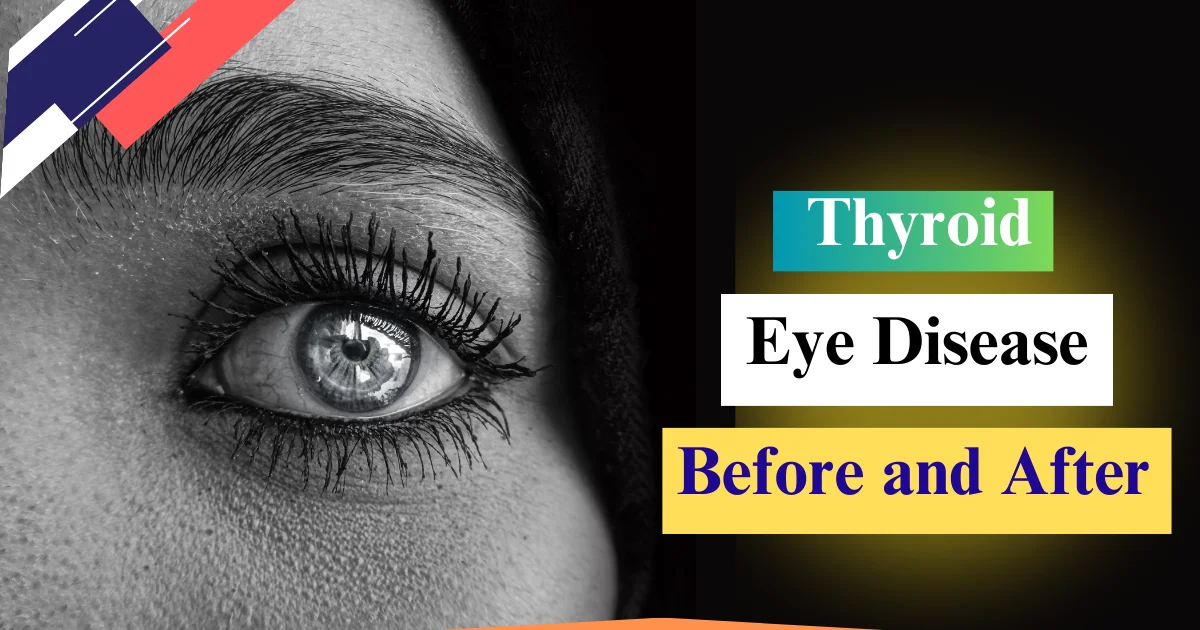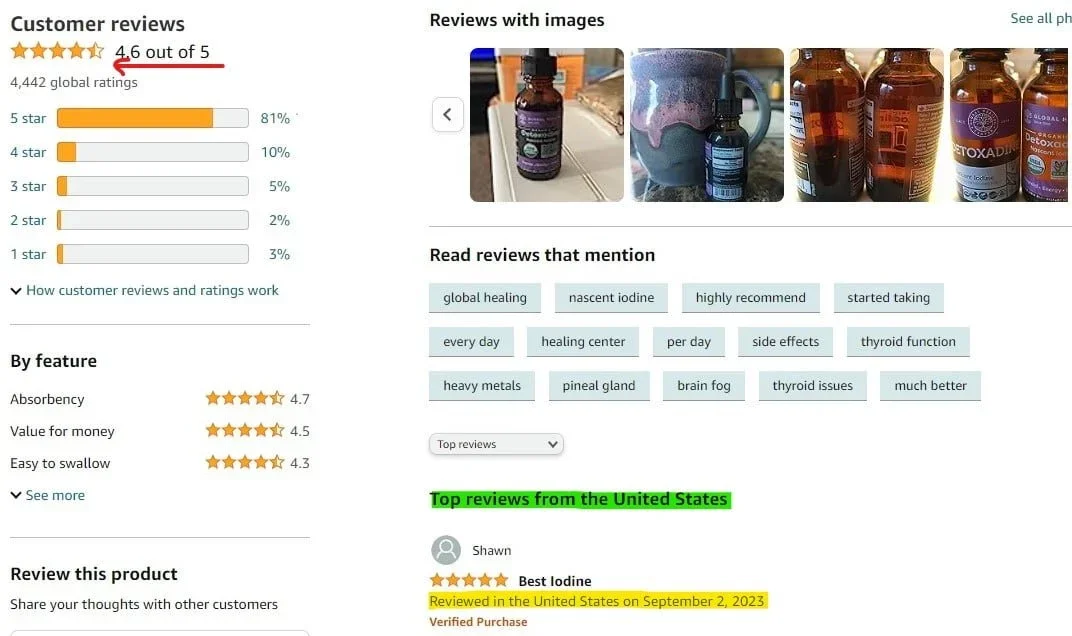Introduction: Thyroid Eye Disease Before and After
We will discuss the effects it has on thyroid eye disease before and after. Thyroid eye disease (TED), also known as Graves’ ophthalmopathy or Graves’ eye disease, is an autoimmune condition that affects the eyes and is often associated with an overactive thyroid (hyperthyroidism). TED can cause a variety of symptoms and physical changes in the eyes and surrounding tissues. In this blog post, we will trace the journey of individuals who have experienced TED and the changes they have experienced in terms of both symptoms and appearance from the “before” to the “after” phase of diagnosis and treatment.

Table of Contents: Thyroid Eye Disease Before and After
1.Understanding Thyroid Eye Disease
Before delving into the before and after aspects, let’s first understand what TED is and how it affects individuals.Before being diagnosed with TED, individuals may experience various symptoms, which can vary in severity. Some common symptoms include:
1. Eye Irritation: Patients often report feeling like there’s something in their eyes. They may experience itching, dryness, and redness.
2.Bulging Eyes (Proptosis): One of the hallmark signs of TED is proptosis, where the eyes bulge forward. This can lead to a wide-eyed, staring appearance.
3.Double Vision (Diplopia): TED can affect the eye muscles, leading to double vision, which can be especially troublesome in daily activities.
4. Swelling and redness: The eyelids may become swollen and red, giving a puffy appearance.
5. Sensitivity to Light: Increased light sensitivity is another common symptom.
2. After TED Diagnosis and Treatment
Once diagnosed, TED patients embark on a journey of treatment and management. The “after” phase can bring significant changes and improvements.
1. Medical Management: Treatment often involves medications to manage symptoms and inflammation. These can help reduce redness, swelling, and discomfort.
2. Radioactive Iodine Therapy: In some cases, individuals with hyperthyroidism may receive radioactive iodine therapy to regulate thyroid hormone levels, which can also impact the progression of TED.
3. Surgery: In severe cases, surgical interventions may be necessary to correct proptosis or other eye issues.

4.Transformation and Coping:
The “after” phase of TED is marked by transformation, not only in terms of physical appearance but also in the way individuals cope with the condition.
3.Physical Transformation Thyroid Eye Disease Before and After
1. Reduction in Proptosis: With proper treatment and management, proptosis can often be reduced, bringing the eyes back to a more natural position.
2. Improved Eye Comfort: Medications and therapies can alleviate discomfort, itching, and dryness, significantly improving daily comfort levels.
3.Resolution of Double Vision: Many patients experience a reduction in double vision, or it may even resolve entirely with treatment.
4.Emotional Transformation Thyroid Eye Disease Before and After
1. Boost in Confidence: As physical symptoms improve, individuals often regain their confidence and self-esteem.
2. Support Networks: TED patients often find support in online communities, local support groups, or through medical professionals who specialize in the condition. Sharing experiences and tips can be invaluable in coping with TED.
3.Embracing Change: Some individuals may explore makeup techniques or eyewear that suits their new appearance, embracing the change with a positive attitude.
5.Lifestyle Adjustments Thyroid Eye Disease Before and After
Managing TED often involves making certain lifestyle adjustments to accommodate the changes in vision and appearance. These adaptations can vary from person to person but may include:
1.Wearing Eye Protection: To shield sensitive eyes from harsh sunlight, wind, and dust, many individuals with TED wear sunglasses or wraparound eyewear.
2. Artificial Tears: Using artificial tears or lubricating eye drops can help alleviate dryness and maintain eye comfort.
3. Dietary Choices: Some TED patients find that certain dietary modifications, such as reducing salt intake, can help reduce fluid retention around the eyes.
4. Stress Management: Stress can exacerbate TED symptoms.
6.Monitoring and Long-Term Care Thyroid Eye Disease Before and After
While TED can improve with treatment, it’s essential to recognize that it may require long-term management. Regular follow-up visits with healthcare professionals, including endocrinologists and ophthalmologists, are crucial to monitor thyroid function and eye health.
7.Embracing Change and Raising Awareness
Many individuals who have experienced TED find strength in embracing the changes that the condition brings. They become advocates for TED awareness and education, helping others understand the challenges and treatment options available.
8.The Role of Support Systems
Support from family, friends, and healthcare providers is instrumental in helping individuals navigate the “before” and “after” phases of TED. Having a support system that understands the condition and provides emotional support can make a significant difference in a person’s journey.
9.Ongoing Symptom Management
Managing TED often involves a continuous effort to control and alleviate symptoms. Here are some strategies for ongoing symptom management:
1. Medication Adjustment: Medications may need periodic adjustments to maintain symptom relief and thyroid hormone levels.
2. Regular Eye Exams: Routine eye exams are essential to monitor the progression of TED and to detect any complications early.
3. Smoking Cessation: For individuals who smoke, quitting is highly recommended. Smoking can worsen TED symptoms and delay recovery.
10.Surgical Interventions Thyroid Eye Disease Before and After
In some cases, individuals with TED may require surgical interventions, especially if they experience severe symptoms or if the condition does not respond well to other treatments. Surgical procedures may include:
1.Orbital Decompression: This surgery aims to create more space for the eye within the eye socket and can help alleviate proptosis.
2. Eyelid Surgery (Blepharoplasty): Patients with severe eyelid retraction or swelling may benefit from eyelid surgery to improve both appearance and function.
3.Eye Muscle Surgery: Corrective surgery may be performed to treat double vision by adjusting the positioning of eye muscles.
11.Emotional Support and Coping
Living with TED can be emotionally challenging, and individuals may continue to face ups and downs in their journey. Emotional support remains crucial, and it’s essential to:
1.Stay Connected: Engaging with support groups or counseling can provide a safe space to discuss concerns, share experiences, and learn coping strategies.
2. Mental Health: Addressing mental health is equally important. TED patients may experience anxiety, depression, or body image issues, and seeking professional help when needed is essential.
12.Raising Awareness and Advocacy
Many individuals who have gone through the TED journey become advocates for awareness and research. By sharing their stories and participating in advocacy efforts, they contribute to raising awareness about TED and the importance of early diagnosis and treatment.
13.Lifestyle Adjustments for Long-Term Health
1.Regular Exercise: Engaging in regular, low-impact exercises can help maintain overall health. It’s essential to choose activities that are gentle on the eyes, such as walking, swimming, or yoga.
2.Dietary Choices: A balanced diet rich in antioxidants and nutrients can support eye health. Including foods like leafy greens, fish, and fruits in your diet may be beneficial.
3. Avoiding Triggers: Identifying and avoiding triggers that worsen TED symptoms is key. This may include environmental factors like allergens or exposure to smoke.
14.Eye Protection Thyroid Eye Disease Before and After
Continued eye protection is essential for individuals with TED to minimize symptoms and maintain eye health. Consider these protective measures:
1. Eye Lubrication: Continue to use lubricating eye drops or ointments as needed to prevent dryness and irritation.
2. Sunglasses: Wear sunglasses with UV protection, even on cloudy days, to shield your eyes from harmful UV rays and reduce light sensitivity.
3. Eye Shields: Eye shields or moisture chamber goggles can provide additional protection from environmental elements and help alleviate symptoms.
15.Body Image and Self-Esteem
TED can impact self-esteem and body image due to physical changes in the eyes and face. Strategies for maintaining a positive self-image include:
1.Cosmetic Techniques: Explore makeup techniques that can enhance your appearance and make you feel more confident.
2.Eyewear: Stylish eyeglasses or frames can complement your appearance while providing comfort and protection.
3. Self-Care: Engage in self-care routines that boost self-esteem and promote mental well-being. This may include hobbies, mindfulness practices, or self-affirmation exercises.
16.Advocacy and Support
Many TED patients find fulfillment in advocating for awareness and supporting others facing similar challenges. Consider these ways to get involved:
1. Join Support Groups: Join or create local or online support groups to connect with others experiencing TED.
2. Participate in Research: Some TED patients choose to participate in clinical trials or research studies aimed at improving treatment options.
3. Educate Others: Raise awareness about TED within your community and among healthcare professionals to ensure early detection and appropriate care.
Conclusion:
In the world the journey from of Thyroid Eye Disease before and after diagnosis and treatment is one of transformation, resilience, and adaptation. Before diagnosis, individuals may grapple with challenging symptoms that affect their eyes, appearance, and overall well-being. However, with proper medical care, lifestyle adjustments, and unwavering determination, the “after” phase brings about significant improvements in physical symptoms, emotional well-being, and quality of life.
It is important to recognize that TED is a lifelong condition that may require ongoing management, but with a supportive network, access to medical expertise, and a positive outlook, individuals with TED can continue to thrive and inspire others with their remarkable journeys. The strength and determination exhibited by TED patients are a testament to the human spirit’s ability to endure and overcome adversity, proving that even in the face of challenges, there is hope, transformation, and the opportunity for a fulfilling life.
Global Healing Detoxadine- Organic Drops for Thyroid Support,

Manufactured in the USA: Detoxadine is manufactured in our very own, state-of-the-art cGMP-certified facility in Phoenix, Arizona. We pride ourselves on quality, which is why all bottles come with a 30-day guarantee, produced right here in the USA

Frequently-asked questions:
1. What are the common symptoms of TED “before” diagnosis?
Before being diagnosed with TED, individuals may experience symptoms such as eye irritation, proptosis (bulging eyes), double vision (diplopia), eyelid swelling, and sensitivity to light.
2. What happens “after” TED diagnosis and treatment?
After diagnosis, individuals embark on a journey of treatment and management. The “after” phase involves medical treatment, lifestyle adjustments, and potentially surgical interventions to alleviate symptoms and improve eye health.
3. What physical transformations can individuals expect “after” TED treatment?
Physical transformations may include a reduction in proptosis (eye bulging), improved eye comfort, resolution of double vision, and reduced eyelid swelling.
4. Are there any long-term considerations for living with TED?
Individuals with TED may need ongoing monitoring and adjustments to their treatment plan. Regular eye exams and maintaining overall health through lifestyle choices are crucial.
5. Can I lead a fulfilling life “after” a TED diagnosis?
Absolutely. With proper care, support, and a positive outlook, individuals with TED can continue to lead fulfilling lives, pursue their interests, and contribute to their communities.